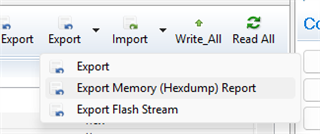Other Parts Discussed in Thread: BQSTUDIO
Tool/software:
Hello,
I am exporting a hexdump for the above part in BQStudio but the file is incomplete.

The DATAMEMORY section, which is the one I need to program the device cuts at 0x9327, but the actual section should extend far beyond that address.

The goal is to automate programming the device with the host. I would like to load the contents of this section into a C array, enter config update, send its contents 32 bytes at a time, exit cfg update, and done. This works great, except for the part in which we are missing half of the configuration data.
Is there a way to extract the full DATAMEMORY section? I believe I could extract it from the fs file, but it is not as straightforward.
Thanks!

